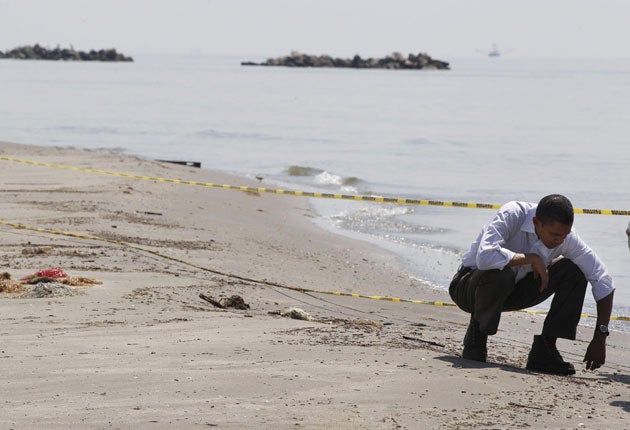Anger grows along oil-ravaged beaches as Obama visits Louisiana

One day after President Barack Obama declared at the White House that he takes responsibility for the calamity unleashed by the British energy firm BP in the Gulf of Mexico, he arrived yesterday to sample for himself the destruction of coastal eco-systems and the despair of those whose livelihoods depend on them.
In Grand Isle, an island in Louisiana, Mr Obama ran into the anger of a population which can't quite believe that the oil spill has happened and that, 38 days later, it still isn't over.
Speaking from the shore, the President said that the disaster was "still evolving". Repeating that he would hold BP accountable for the costs of the spill, he again accepted responsibility – "I am the President and the buck stops with me" – for ensuring the leak is stopped and the oil is cleaned up. But, he warned, the problem was so novel that even the experts will be learning as they go along.
"There are going to be a lot of judgement calls involved," he said. "There aren't going to be perfect answers."
As they watch the oil wash ashore, residents fret that a way of life is over. "Generations might be gone and young children may not ever know this life," said Dina King, adding that the Obama visit doesn't help. "He ain't gonna make a difference. The government hasn't done anything."
Fifty miles from Grand Isle, BP engineers persisted in their "top-kill" efforts to drive down mud into their ruptured well to the point where they can seal it over with cement. But the company's CEO, Anthony Hayward, made clear that success remained elusive.
"These operations continue and ... the procedure could extend for a further 24 to 48 hours," he said. "Its ultimate success is uncertain." Information from BP on progress remained sketchy and not necessarily reliable. The effort began on Wednesday but was suspended for 18 hours through most of Thursday even as the world was under the impression it was still going forward.
It was not even clear that Admiral Thad Allen, the Coast Guard Commander, was getting the full picture from BP. But last night he voiced optimism that the bid to cap the well would work. "I think the real challenge today is going to be to sustain the mud on top of the hydrocarbons and reduce the pressure to the point where they could actually put a cement plug in," he told reporters.
The region suffered further bad news after marine researchers reported a second underwater plume of crude oil leaking from the site. This one, they said, reached to depths of more than 3,000ft and was moving in the direction of a sea bed canyon that funnels currents south towards the Florida Keys. On Thursday, a government agency revised upwards the rate of the leak to between 12,000 and 19,000 barrels a day, making this disaster far more serious than the Exxon Valdez.
Asked why the impression was allowed to hang through much of Thursday that the pumping was continuing at the site, Andrew Gowers, a spokesman for BP, responded: "We have to be tight about communication so as not to mislead the market."
Yesterday's was the second visit by President Obama to the Gulf region and he continues to fend off suggestions that his administration has been slow to react. The BP spill is threatening to grow into his version of Hurricane Katrina. The bungled handling of that disaster perhaps did more than anything to sabotage the legacy of his predecessor George Bush.
Subscribe to Independent Premium to bookmark this article
Want to bookmark your favourite articles and stories to read or reference later? Start your Independent Premium subscription today.

Join our commenting forum
Join thought-provoking conversations, follow other Independent readers and see their replies